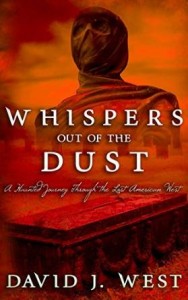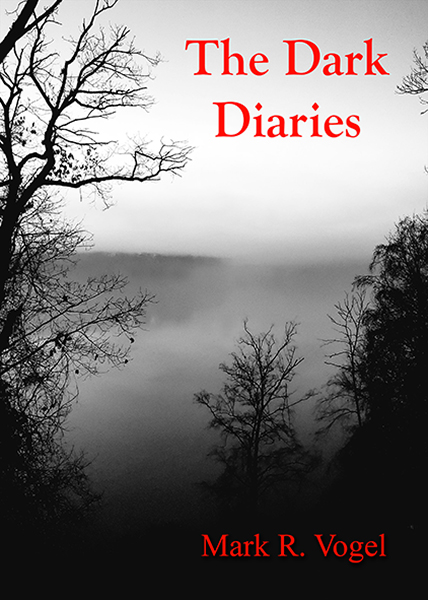
David J. West
Lost Realms Press
October 3, 2015
Reviewed by Michael R. Collings
In Whispers out of the Dust: A Haunted Journey through the Lost American West, David J. West has created a fascinating and fun amalgam of fact and fiction, narrated using multiple “found” documents, each reflecting the time, the culture, and the perspective of its author. Beginning with the “Foreword,” he makes clear his intentions:
“The pulp fiction hard in me is still very much alive despite this black pilgrimage into the wilds of academic and non-fiction. My wanderings herein lean toward storyteller and grim chronicler rather than documentarian or, heaven forbid, ‘respectable writer’.”
“Storyteller and grim chronicler” he is, as the controlling voice recounts the discovery of an ancient trunk at a thrift story in Las Vegas—dutifully identified via academic-style footnote as a branch of Deseret Industries, an actual chain of stores in several states throughout the West. Inside, he discovers a “toad-like idol,” a reference that will trigger of shimmers of anticipation in Lovecraftians. Accompanying the idol (and, lest one distrust the narrator’s tale, West includes a photograph of said item) is a collection of papers dating from the Spanish conquest in the mid-sixteenth century to August of 1938—the date when the area was flooded by the opening of Hoover Dam.
“The Toad in My Study; Or How I Found these Mysteries” is followed by “Jornada del Muerte—Statement of Elias McGinnies: January 1865,” which tells of the discovery of two Spanish skeletons while McGinnies was clearing his fields in the newly established Mormon settlement of St. Thomas, some ways south of St. George. Buried with the bones was a small chest containing a blue bottle with papers rolled inside—and again, West provides a photograph of the “original blue bottle.” Translated from Spanish, the papers are all that remain of Diego de la Vega Matamoros (d. 1540) and reveal the first encounter of white men with “Things lost on the borders of dust [that] were never meant to be found.”
The twenty stories in Whispers Out of the Dust expand upon the image of an ancient evil, a pervasive darkness, a palpable monster from the wind-scoured buttes surrounding St. Thomas as straggling waves of settlers arrive, attempt to forge a living from the desert, and finally—if they are among the lucky ones—realize that there are things out there that must not be tampered with, and depart. The unlucky ones…well, they remain, and the lucky among them die quickly.
Throughout, West peppers the tales with tidbits of Western lore, many of them drawn from Mormon history. Orrin Porter Rockwell, Joseph Smith’s erstwhile bodyguard, appears several times; and, in fact, the ghost of the Joseph Smith himself plays a key role in one story, designed to illustrate the fate of those who martyred the Prophet, at least in the eyes of nineteenth-century Saints. Even that ancient mage, Hermes Trismegistus, appears in a reference to add verisimilitude to a mystical attempt to open a forbidden doorway between this world and…somewhere else.
There are other, more traditional, ghosts as well, as in the poignant “A Rose for Miss Dolly” (West has read his Faulkner) or the more strictly terrifying “The Groaning Desk.” Some of the creatures are safely put to rest, as in “The Thing in the Root Cellar,” which provides a nicely naturalistic conclusion to a quasi-supernatural account; or in “Bury Me Deep,” in which water finally cleanses the earth of a stain. And all of them could legitimately close with the final paragraph of that story:
There are dark things in the world, dark happenings that no one else sees, but they abide there on the borders of nightmare, waiting.
Whispers Out of the Dust is more than a collection of short stories; every tale is linked to every other by landscape—which, much like the moors in Wuthering Heights, is so pervasive as to become almost a character itself; by the sense of oppressive history taking its toll on the (then) present; by characters who speak idiosyncratically, who think and believe in ways foreign to modern readers; and by an overarching futility as, time and again, optimism gives way beneath the weight of hauntings and whisperings. Yet at the same time, it does not pretend to the coherence and organization of a novel. These tales do not develop a single theme or focus on a single character, action, or culture. Nor should they. They are as disparate as what one might expect to find—hope to find—fear to find—in an abandoned trunk rescued from certain oblivion in the shadows behind a thrift store.
- Killing Time – Book Review - February 6, 2018
- The Cthulhu Casebooks: Sherlock Holmes and the Miskatonic Monstrosities – Book Review - January 19, 2018
- The Best Horror of the Year, Volume Nine – Book Review - December 19, 2017
- Widow’s Point – Book Review - December 14, 2017
- Sharkantula – Book Review - November 8, 2017
- Cthulhu Deep Down Under – Book Review - October 31, 2017
- When the Night Owl Screams – Book Review - October 30, 2017
- Leviathan: Ghost Rig – Book Review - September 29, 2017
- Cthulhu Blues – Book Review - September 20, 2017
- Snaked: Deep Sea Rising – Book Review - September 4, 2017


